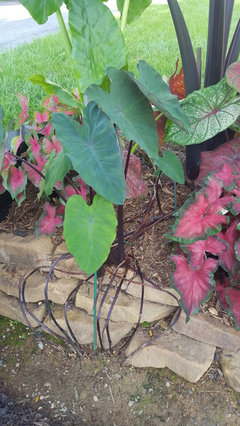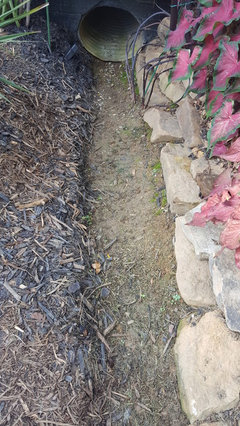Giant EE Propogation/Division
I hope I can get some ideas on how to most affectively increase my population of EE. My plant, though I don't know the name, is a very large one and looks a lot like Jack's Giant, but a bit smaller.
For one, I can see some "babies" that have shot up near the plant base that I will seperate and transplant.
Now that being said, is there other ways to propogate these things like corm division?
I see a flower starting to come up. Will the flower offer any opportunity to acquire seeds?
I'm very excited about this plant because it is one of the very few exotic tropicals that will vigorously grow in the hot Texas weather and calcified caliche soil here in San ANtonio. The calcified soils prevent most plants from absorbing enough nitrogen to get very green. But this plant is a beautiful dark green color. A rarity in this area.
Thanks in advance for your responses.
Comments (7)
dirt_tracker Alabama Zone 8A
6 years agolast modified: 6 years agoReviving a very old post, but I'd like to know the answers to some of those questions. I have about 20' of a small gray-water drainage ditch that I'd like to plant some EE along. I've spotted some in a ditch close to me that apparently have naturalized from a nearby trailer park. I'm thinking of acquiring some of them. One concern I have, though, is that they are on state ROW at the mouth of culvert that goes under the highway...I'm sure they've been sprayed or will be sprayed....Alabama is notorious for spraying ROWs. :( Their coloring appears similar to Jack's Giants but I don't think they're quiet that big. It will take some division and propagation to cover 20' of ditch. :)
So, anybody got any tips or suggestions on propagation? Thanks!
dirt_tracker Alabama Zone 8A
6 years agoSearch engines are our friends. :)
Propagation seems very straightforward... What I've gleaned from the internet...subject to correction. :)
Simple tuber/corm division in the spring appears to work very well...separating large tubers and the small babies that formed the previous season. Plant the different varieties 2-6 feet apart in rich, moist soils...larger varieties naturally go further apart. I've seen to plant them with one inch to four inches of soil covering them. They can be propagated by seed, but normally only a few seeds are produced and may require hand-pollination...division of the tubers/roots/corms is the most efficient means of propagation. The bigger the corm/tuber is at the beginning of the season then the bigger the plant will grow during that current season.
If you have limited area to plant them in choose a "clumping" variety....if you're wanting to cover a larger area then a "runner" variety will spread more on it's own. If you live in an area conducive to naturalization...maybe Zone 8 and southward then be aware that the runner type can become a noxious weed and a clumping variety might be your better choice for controlling it's growth and spread...especially if you're growing it close to a body of water.
Hopefully I didn't err too much in all that... :)
Related Professionals
Citrus Heights Landscape Architects & Landscape Designers · South Elgin Landscape Architects & Landscape Designers · Brooklyn Park Landscape Contractors · North Ridgeville Landscape Contractors · Avon Lake General Contractors · Binghamton General Contractors · Boardman General Contractors · Lakeside General Contractors · Leon Valley General Contractors · Palestine General Contractors · Cedar Park Siding & Exteriors · Conyers Siding & Exteriors · North Bellmore Siding & Exteriors · Philadelphia Siding & Exteriors · South Glastonbury Siding & Exteriorsjay
6 years agolast modified: 6 years agoMaybe put up some 'Do Not Spray' signs where needed. Make them look like others that may exist in the area. I see them a lot where our state plants wildflowers on roadsides and green medians.
I separate Alocasia pups in the fall and Colocasia pups all growing season with success. My EEs are all along a ditch. I have 7 of them.
Try Alocasia Calidora or Alocasia California but ask around at local nurseries until you feel you have an informed answer for your state. Don't try EE Black Magic or EE Illustris. They spread like wildfire in a half-season and I'm in z7.
Hope this helps.
dirt_tracker Alabama Zone 8A
6 years agoThe area that I'll be planting in is an isolated wet area from a gray water drain outlet. The surrounding area should be rather dry throughout the summer growing season so I'm hoping to limit the EE's spread to along the wet ditch area. When I speak of a the drain it is only for a kitchen sink, dish washing, hand washing, vegetable processing, etc.,. It's not a tremendous amount of water but enough, I believe, to sustain a nice spread of EEs but yet limited in the area that is wet in a wait to restrain the spread of the EEs...I hope. :)
I'm kind of worried about the state spraying the ROW...this area is near the highway... the southern/far end of the drainage may be just touching the ROW but hidden/shielded behind an old, overgrown fence row of privet hedge.
The area where the ditch is has just had the brush cleared off (mostly privet) and is beneath a couple of large trees. It seems rather rich, though I'm sure it's weedy and viney. Being beneath the trees it's shaded during the middle parts of the date, getting good low-angled sunlight in the mornings and evenings. I would say the shading isn't complete, with some mottled sunlight coming through during the middle of the day.
One question I have about the EEs is how concerned should I be about the possibility of them clogging the drainage ditch? This is really a small ditch, probably no more 10"-12" deep and maybe 12" wide...a new ditch cut when the brush clearing was done. The land slopes in the desired direction of the ditch. I'm thinking to plant the EEs maybe a foot to either side of the ditch and zig-zag the plants crossing back and forth over the ditch with maybe 3' between them.
As for acquiring some of the naturalized plants. Would my best bet be to wait until after frost and over winter the bulbs out of the ground? We really don't have frozen ground around here in the winter but we will get frost and freezing temperatures that will kill or kill back tender plants. Or, should I go ahead and dig some while still growing and plant now??? Once planted I do not intend to dig them up for over-wintering inside so hopefully they will tolerate our temperatures. :)
Thanks for any suggestions or recommendations!!! Ed
jay
6 years agolast modified: 6 years agoWith a clumping EE, you will probably be fine as far as clogging the ditch. My ditch is roughly the same size and EEs are ~18-24" away. You might be able to leave them in the ground in winter there. I read all over that I cannot where I am.
I'm not sure how much this below will help - but you could use it as a baseline. See what others post as well...
Right side of culvert - here I trained and secured the Colocasia Esculenta 'Black Magic' roots/runners/rhizomes to grow to a specific area of the ditch. They don't affect the water flow during storms. The base of the parent plant can be seen along the top right. Last year I cut them all off and that plant was only ~4' tall. So maybe leaving them be increases the parent's size:

Another view of the ditch. You can't tell but deer mesh holds the left side much in place with stiff wire anchors that you also can't see. Otherwise the mulch will wash away as the culvert gets half full with water sometimes:
Here you can see the placement of 2 of the 5 EEs in this planting in relation to the ditch, as well as a 7 1/2 ' tall Rose Mallow Swamp Hibiscus 'Tie Dye' on the left. The center EE is 6'-4" tall but it doesn't look it in the pic:

This is the left side of the culvert planting. The EE on the left is a 6'-1" Alocasia Macrorrhizos 'Black Stem'. I specifically placed all these Aroids next to the ditches so they could slurp more water should they want it. I've only seen the EE roots down low though when I re-positioned some of the rocks. My larger goal was to pretty-up something ugly:

dirt_tracker Alabama Zone 8A
6 years agoThanks for the feedback, jay. It sounds like I need to space them a little bit further away from the ditch than I had planned, no problem. Yes, the ones I've spotted naturalized appear to be handling the winters here pretty good. There is also more of the EEs there than I first thought, rather than just at the mouth of the pipe coming out from under the road they travel on down that ditch probably 30'. I'll be looking foward to seeing your planting. Thanks.!







tropicbreezent